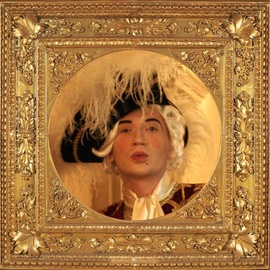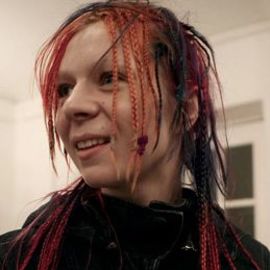Armen Avanessian: «Institutions have much more impact and therefore much more power than they know»
'Til July 22nd, the second part of the exhibition "General rehearsal", a joint project of the V-A-C Foundation and MMOMA, takes place at the Moscow Museum of Modern Art on Petrovka. The second act's theme, "Metaphysics of the Future", is also the name of a philosophical play by Armen Avanessian, acted out with exhibition artworks. Andrei Shental sat down with Austrian philosopher to discuss the "speculative turn", the power of intuition and the new meaning of realism.
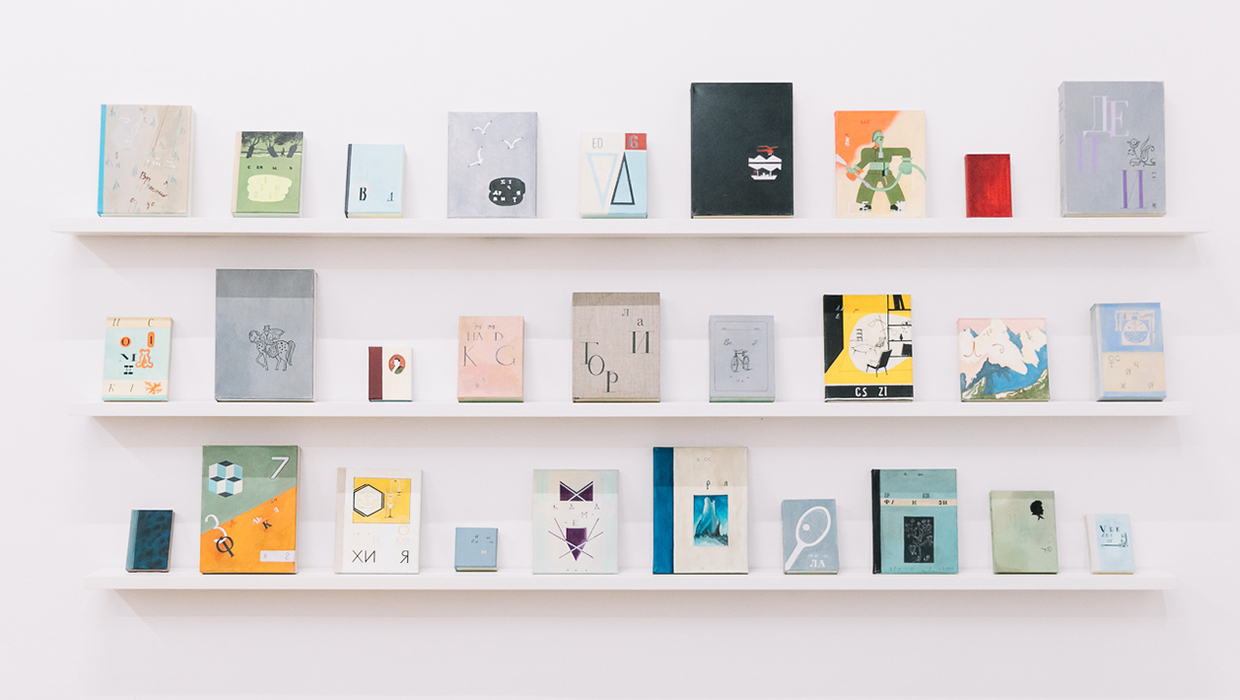 Daria Irincheeva. Empty Knowledge. 2011–2016. Oil and ink on canvas (28 works). Collection of V-A-C Foundation. Photo: Mark Seriy
Daria Irincheeva. Empty Knowledge. 2011–2016. Oil and ink on canvas (28 works). Collection of V-A-C Foundation. Photo: Mark Seriy
Andrey Shental: Theater and contemporary art have always had a very tense, contested relationship. Modernist art critics chased away theatricality from art, while today we see how the domain of theater protects itself from art’s expansion into other fields. You curated a program at the Volksbühne theater, and now you have put together a show as a part of the General Rehearsal project. How do you, personally, see this relationship?
Armen Avanessian: I doubt that one can give a general answer, because you mention places that are very different historically, geographically and culturally. Talking about this relationship with regards to Moscow today, or to the classical avant-garde, would be very different from a 1950s–1960s New York context, or that of contemporary Berlin. The debate about Volksbühne has very local specificities, but it also goes beyond these. For example, there is a new element: a general reproach towards or suspicion of contemporary art that is seen as a neoliberal movement responsible for gentrification. I think such a claim is oversimplified — it is not obvious that theater is less neo-liberal.
I am neither a contemporary art person, nor a theater person, so instead of talking about the essence of this or that art form, I am interested in the possibilities for theory, for production of knowledge and what you can gain from the very different expertise and knowledge in theatre and art, but also how the practitioners and practices operate in these different fields. So in that respect I have more neutral or relaxed relationships with both. When I was asked to do something for Volksbühne two years ago, during my involvement with the Berlin biennale, I invited Chris Dercon and others, such as Krist Gruijthuijsen, to do a panel discussion on future institutions, which is also important with regards to the V-A-C project. And one of the key questions that I ask myself is: what function does theory have today? What can you learn about thinking from people whose profession does not involve writing, or thinking in words.
Having said all that, it would be wrong or pretentious if I said something general about theater and contemporary art. I’m currently more fascinated not with the artist, actor, filmmaker or director, but by ‘middle’ figures such as curators, dramaturgists and producers. How do they overlap? How can one learn from the other? Am I, myself, curating theory? Partially, yes. Is it dramaturgy because it means working with words and with texts? Is it also producing? If I edit a text on a certain topic for a book I put together, am I working like a music producer in a studio? Someone else comes with an individual article, melody or whatever, and I put it in a context. I might integrate it into the field of art via an exhibition. Therefore one could also say this is the role of a producer, and it is such figures I find particularly interesting. Therefore my expertise is more applicable to these questions than to a historical comparison of the influence of theater and the arts.
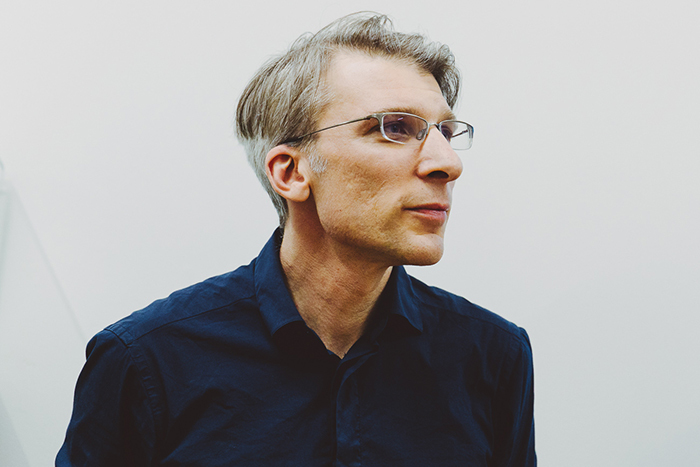
A.S.: But your project is positioned as an act; you wrote a libretto, which means that artworks ‘behave’ a bit like actors on a stage.
A.A.: It is used as a libretto, but I think it will be much less a staging thing. My main interest here is rather to use artworks of the 20th century — older agents — and see what they can tell us about the recent time and about the future, and recontextualize the 20th-century artworks mostly as 21st-century artworks. So for me the dominant question was not so much about absorption and theatricality, they were not in the foreground.
A.S.: You work with such fundamental categories — particularly substance and accident. How do you resolve the problem of contingency and accident, when it comes to three collections — a very particular selection of works — determined by historical circumstances and personal tastes?
A.A.: The first challenge is that you get asked to write something for an occasion, with never as much time to prepare as one would like. So there is already a contingent element. You can only work with the ideas you currently have; you cannot drop everything and start thinking about something totally different. Also 95 percent of the artworks I was dealing with were not the kind that I would usually think of with regards to questions of technology or geopolitics. But as I already said, for me this was not an obstacle but a challenge to integrate many of these 20th-century artworks into a 21st-century narrative. It’s important to me that this adventure or experiment is in correlation with what I understand as the whole endeavor of this institution that is in the making. This is not just an exhibition where a curator comes in with certain ideas and he chooses the artworks. No, rather it is a rehearsal, a kind of study of the birth of an institution (which consists not only of artworks but mainly of people) observing how it is flexing its muscles, figuring out how to move, and trying to understand how the whole fascinating machine could work. It is not a classical exhibition, but the rehearsal of an institution to come. Of course it should also be seen as an exhibition, but it has a very different genesis.
A.S.: You selected many local artists for your project. What made you choose them? Do you know their backgrounds and what is your overall impression of Russian art?
A.A.: Again, I am not a professional art curator and not an art person in general. But I knew some and I had the information about the artworks and the descriptions of the works and the artists. Take, for example, the decision to choose father and son Avdey and David Ter-Oganyan,. with their specific trajectory and tradition, certain conflicts and reputations — all that plays into the whole thing. Apart from Francesco Manacorda, I mainly worked with an amazing Russian team, so the whole thing was, luckily, a collaboration. Of course, I tried to get as much information as possible from them. Distinctions such as Russian and non-Russian, male and female were not in the foreground, but rather the philosophical or metaphysical categories, such as contingency, that I wanted to define the chapters of a book too. So, from the beginning, the whole project was also a rehearsal for a book with these 11 topics. Constraints or apparent obstacles help me to create an order, otherwise I can spend far too much time trying to decide whether it’s two chapters or five. But in this case 11 was the number, given the rooms available for the show. That’s why it is also a staging of the creation of a book that I really wanted to write. So in a way I am trying to use these artworks to aid my my thinking process.
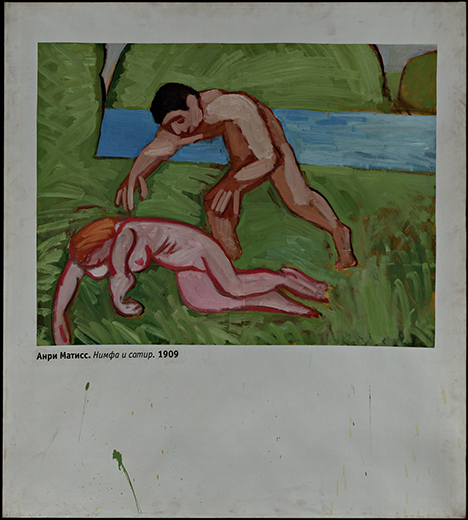
A.S.: There is a common view of the exceptionalism of Russian art — that it does not fit into mainstream narratives and is always excluded, and that you always have to take into account its unique history. Here, you subsume these complexities easily under abstract categories.
A.A.: First of all, the works are part of the collection. Maybe one needs to have a closer look at whether some fit better than others, but actually these are questions for the art critic. What I like about this project is that of course you produce something that is open to art criticism, but also you do something very different. It is a vehicle for me to start thinking about a book and philosophical questions. It was quite a challenge for me to write such short texts, and for a non-philosophical audience. Even though I have so much other work to do, I have more or less finished writing the book now, because I was really submerged in it. I investigate these artworks and think about them. It was such an intense writing process that I could not stop in a way.
A.S.: There is nothing new about returning to metaphysical problems. We are familiar with y Heidegger’s destruction of metaphysics and Derrida’s theory of deconstruction. Why examine metaphysics again? And why metaphysics for or from the future?
A.A.: Over the past 200 years, most philosophers tried to reject metaphysics only to realize that it is still here. Nietzsche did so, then Heidegger said Nietzsche was the last metaphysician, and then Derrida objected to Heidegger, and so on. Today, on the contrary, we witness a ‘speculative turn’. This book does not celebrate metaphysics in a classical sense but, rather, speculation. What it says is not that we should go back to traditional metaphysics, but as philosophers and non-philosophers we return to, we operate, we work with, we think about and react to these categories that are sometimes 2500 years old. We use substance and accident or we say ‘this is essential and this is just accidental’.
Even in our conversation, in all my answers and all your questions, such categories repeatedly arise. Instead of trying to completely deconstruct and get rid of them, my hypothesis is to question how we use them today. What do they mean now, given that we live in a radically new time? And as you mentioned substance and accident, it is not just me saying this. We use some of these concepts in a way that is absolutely unique to the late 20th and early 21th century (for example technological, nuclear or algorithmic accidents that threaten what seems to be ‘substantial’), so this is not a meaning it could have had in the 19th or seventhh century. In that sense it is useful to work with these categories, but revise them. What you say about contingency and probability is related to Quentin Meillassoux’s thinking. He is against metaphysics, yet he poses metaphysical questions. For example, his idea of ancestral time questions how our human time comes into being? Why is there is anything and not nothing? How does anything come into existence? These are all good old metaphysical questions.
Another example is form and matter (quite at the beginning of the exhibition and the book). What does it mean to think about form and matter? From the point of view of aesthetics, they are always related and one influences the other. But, in a radical way, what nanotechnology teaches us today is that form actually changes the matter itself, and does not just mold it externally. The natural sciences in general also have an impact on metaphysics while simultaneously operating within a metaphysical framework. So people can criticize my approach, or might not get my point, but this is simply the working hypothesis of the whole project. Tell me, do you find it unconvincing?
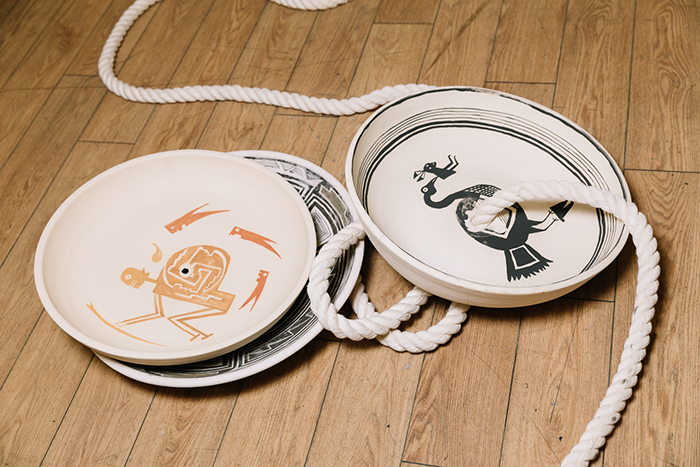
A.S.: I find it interesting, but I am not sure if I find it convincing. Recently I was at the Riga Biennial, and the whole giant show was about acceleration and change in all possible fields. It claimed the change is so rapid we do not notice it. Towards the end I even thought maybe the opposite is the case: there is no change. So I wonder to what extent it is justified to say that now (not in some past period) change has become so fundamental that even the immutable categories are subject to transformation?
A.A.: I really think that things change. We are about to witness a massive change due to new technologies. Of course that was always the case, in the 1930s things changed and in the 1950s everyone got television and so on. But for me, the change with digitalization is as massive as with the printing press (unlike steam trains or electricity, which also had an impact but not on such a fundamental level). It is a more fundamental change on all levels of culture, politics and society, which we have not grasped yet or come to terms with. Obviously digitalization has an impact on key categories that we work with, including substance, form and matter, and time. But this is not just time changing as usual or things changing more quickly; it is not about speed or acceleration in terms of quantity. It is a more fundamental and qualitative change. That is what I say in the ‘Time’ chapter with the hypothesis that, acceleration is maybe an impression we have, but it is not the explanation. A better explanation for our feeling of not gaining traction anymore in the present, the explanation for our irritation and confusion, is that the direction of time has changed.
With regards to your observation in Riga, I agree with you. It is not about acceleration, but that does not mean that the change is not fundamental (which I think it is). This whole focus on and obsession with acceleration is just a symptom of something underneath — a quasi metaphysical change. I am interested in what happens if we look at our reality with such new or revised conceptual tools.
A.S.: In Russia it is popular to speak of both realism — partially to rethink socialist and other realist traditions of the 20th century — and, separately, of speculative realism. You somehow connect these two different terms within ‘referential realism’. What is it? Is it art that does not depict reality (classical realism), or reflect on its very depiction (modernism that is seen as realism by someone like Boris Groys), but rather takes into account complex relationships, entanglements, connections and continuity? How can the philosophical notion be connected with the art historical term?
A.A.: How do you work as a philosopher when you say time comes from the future? How do you work when you no longer say ‘the reality is in front of me and I have to depict it in the now, trying to be contemporary with it?’ I am not just talking about how I think about this and that specific phenomenon, but what does it mean to do philosophy in general. How is this referential realism? My first, rather careful, reply would be that it is not here yet. I am trying to see how something will establish itself that, by definition (given my hypothesis that time comes from the future) has not fully done so yet.
What I am trying to do is to offer a kind of order to confront this confusion of all these realisms that are obviously contradictory. For this I use a kind of semiotics of signifier, signified and the reference. As you know, the classical realism debate comes from 19th-century art-historical and literary theory and discussion. What is narrated? The content is the proof of true realism. Twentiethh-century realism, on the contrary, is rather formalist: a realism concerning the act of narrating, rather than the narrated content.
It’s within this semiotic framework that I propose a third and referential realism, without wanting to label specific novels or paintings as such. Instead, I see certain signposts, indexes or symptoms, like in philosophy’s speculative realism. I once wrote an article about The Wire, the television series which has been described as Charles Dickens for the 21st century. But I would disagree — there are also very different things happening. What does it mean if the former criminal plays a judge or if a policeman plays a criminal? And what impact does this show have on certain societies or the place where the whole thing is staged? But I admit it is very hard to do an epistemic analysis or discourse analysis of the present in the Foucauldian sense — actually it is impossible. But I try to do the impossible even if I risk making mistakes. So I attempt to collect certain elements or indications and discuss what it means today to have series of events and objects and how they communicate with each other without necessarily creating primacy of one over the other. We need to build up a new relationship with this reality in order to make sense of it, make it coherent. That is something that is different from 19th-century ideas of reality as something stable, or to 20th-century doubt that says we shouldn’t trust the obvious reality as it might be ideological, what presents itself as reality is just our relativistic perspective. Yet again very differently I think for us today (and this goes for speculative realism too) there is a reality, but we have difficulties conceptualizing it. It takes a huge speculative effort, or the help of natural science, to uncover this reality and build a certain referential relationship with it. I think these are the new questions and problems. Both the show and my future book are rehearsals — invitations to think about a new approach to reality.
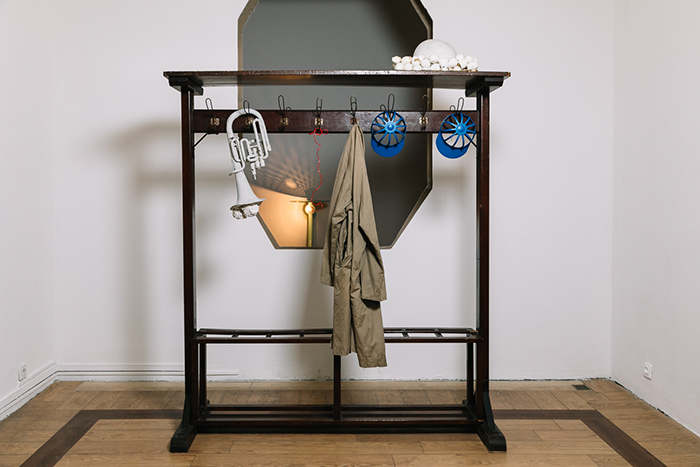
A.S.: Can you give concrete examples of this in terms of particular works? For instance, can we glimpse this new realism in Harun Farocki’s piece?
A.A.: Again you are trying to talk to me about things that are not within my field of expertise. I like that. There is one room with only two works: a video by Fabien Giraud and Raphaël Sibony, and another by Harun Farocki. I thought of them together. What is interesting about Farocki is that obviously he confronts us with very real issues (in the traditional understanding of real and realistic) and in that sense there is a representative element in the work, but at the same time he is a 20th-century artist coming from a formalist and avant-gardist tradition. He is one of my favorite artists, and I thought it would be exciting to put him together with Giraud and Sibony and my text and find out what happens between the three of them. Maybe the viewer realizes that there are all these different realisms, without this becoming blurred, when for example you still have the afterimages of Giraud and Sibony projected on or coming back to you from the screen. It is exciting testing one’s ideas not just as a writer but by using curating as a tool of knowledge production.
A.S.: You claim that art institutions are blind to their own role and that they undermine and undervalue it. What are their influences on geopolitical and ideological agendas?
A.A.: Institutions, including art institutions, have much more impact and therefore much more power than they know. The problem is (and you tell me whether I am exaggerating here) their impact is not where they would like it to be, on the level of content or output (such as books and artworks) being able to change politics or morals, but rather in areas that in general cause bad conscience: money, economy and gentrification. My hopefully provocative ‘institution-realist’ claim is to say let’s examine where the real effects of an institution are and try to mobilize and use them in a more progressive way. You could also call it an accelerationist approach, not to look at the surface and cherished ideas, but instead deal with the schizophrenia of institutions and the people working there who tend to feel torn between what they want to achieve and the impact they actually have (which, as we all know, often have little to do with each other).
Pursuing such topics and questions is not something I can do sitting at home at my desk. It needs to be done working with institutions, trying to reorientate them in a certain way. In order to change institutions one needs to understand them and their real effects, and understanding institutions means trying to change them — the two things necessarily go hand in hand. So what is the impact of a certain institution? And what is an institution in the first place? Marriage, workers’ trade unions, museums and galleries are all institutions. They define and shape our patterns of behaviors. They mold our expectations, how we behave, what we think we should do or not do, because otherwise we might be sanctioned. Even here, our interaction is very much institutionalized. Ninety-five percent of what the two of us here are doing is pre-determined or choreographed by the institutions that brought us here, both through our academic training, and then you as a journalist and me as a philosopher. This reminds me of something Hito Steyerl once said: that art — and I would say the same goes for universities — is very good at politicizing everything, but has a blind spot when it comes to its own politics and working conditions. There are many blind spots, and that is what I am interested in also working on with institutions.
A.S.: So they operate as a kind of transcendental framework.
A.A.: If, for example, the MoMAs of this planet were aware of the impact they have on gentrification and what kind of money they produce for others (quite similar actually to the way we all produce value for Facebook), they could use this insight as leverage and maybe spend some of this potential money on artists and artistic projects instead of passively lamenting gentrification. Instead of doing institutional critique work and then feeling sad that again they have become instrumentalized, we might rather have to embrace to what degree we are part of a processes like gentrification. But only then when one accepts this and take into account the real effects of your practice (not the imaginary political effects of stories told in films or paintings, or in our books or articles), can one start changing it or mobilizing these effects in a somewhat progressive way. If one continues looking at idealistic topics, notions and values, then things will simply continue in the way they do.
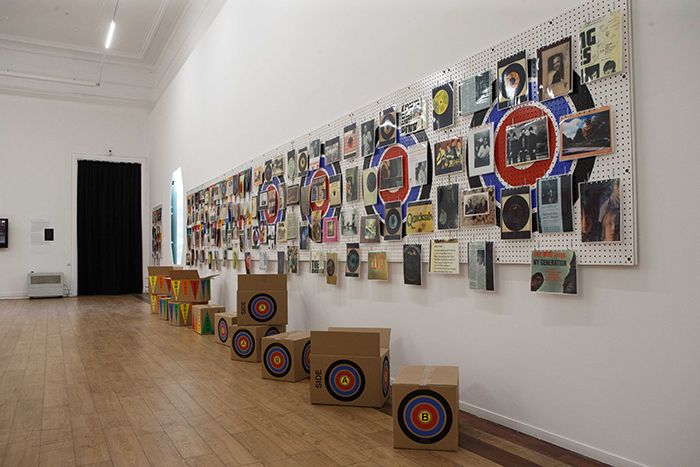
A.S.: It was said that you might write a book after this show, but I gather you have already made quite some progress on it. Also, in your libretto you refer to some other notions that you have developed before: hyperstition (as in your eponymous film), recursion (as in texts on speculative poetics) and so on. Is it also a kind of summary or systematization of your previous work?
A.A.: I tried to write a short and readable book, and I hope it is not a summary or a ‘best of’ my writings so far. Neither hyperstition nor recursion come up, for example, as a chapter in the show, but of course they are concepts that help me understand the world I live in. Recursion is also an important concept in the description of the V-A-C show on the third floor. So some of these concepts were already part of my thinking before, but it would not have made sense to exclude them now. Overall, I was interested in looking at substance and form, matter, truth and thinking, life and other classical philosophical topics and each time coming up with short (and hopefully understandable) texts as well as an interesting show that provokes some thoughts or experiences. And in this sense it was an experiment for sure, but then V-A-C is an experiment as well, so I tried to work in this spirit.
